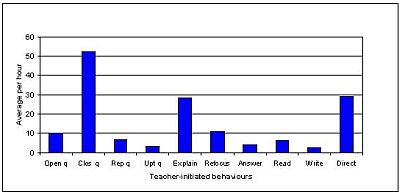- Question (whether open, closed, uptake or repeat)
- Answer
- Explain
- Refocus (get a pupil back on task)
- Read
- Write
- Direct (an instruction to do something)
For ease of data entry, we classified these behaviors as events rather than states. However, we did include one state - stage of lesson. This enabled us to key-in when the lesson had moved between whole class work, group work and a plenary session.
Research [1] suggests that if a pupil is allowed to contribute to the shaping of the verbal agenda in a classroom, the discourse is more effective in helping the pupil to learn. Directive, teacher-dominated discourse is not an effective way to promote higher-order thinking among pupils. Figure 1 shows a typical teacher-initiated discourse profile for a literacy lesson (in England). Ten different behaviors are shown on the x-axis, referring to those bullet-pointed above. This graph shows that closed questions were the most frequent form of discourse behavior (an average of 52 closed questions was asked per hour). The teachers in our sample directed the pupils 29 times per hour and explained 28 times per hour. It is clear that directive behavior is the dominant form of discourse in a literacy lesson.

Figure 1. Discourse profile of a typical literacy lesson.
The CIS is a great improvement upon the paper and pencil techniques traditionally used in the field of education. Data are immediately ready for download and analysis. The system is mobile, easy to internalise and adaptable.
This paper will also discuss some methodological issues we have dealt with when using the system across different projects. These include:
References
Paper presented at Measuring Behavior 2002
, 4th International Conference on Methods and Techniques in Behavioral
Research, 27-30 August 2002, Amsterdam, The Netherlands